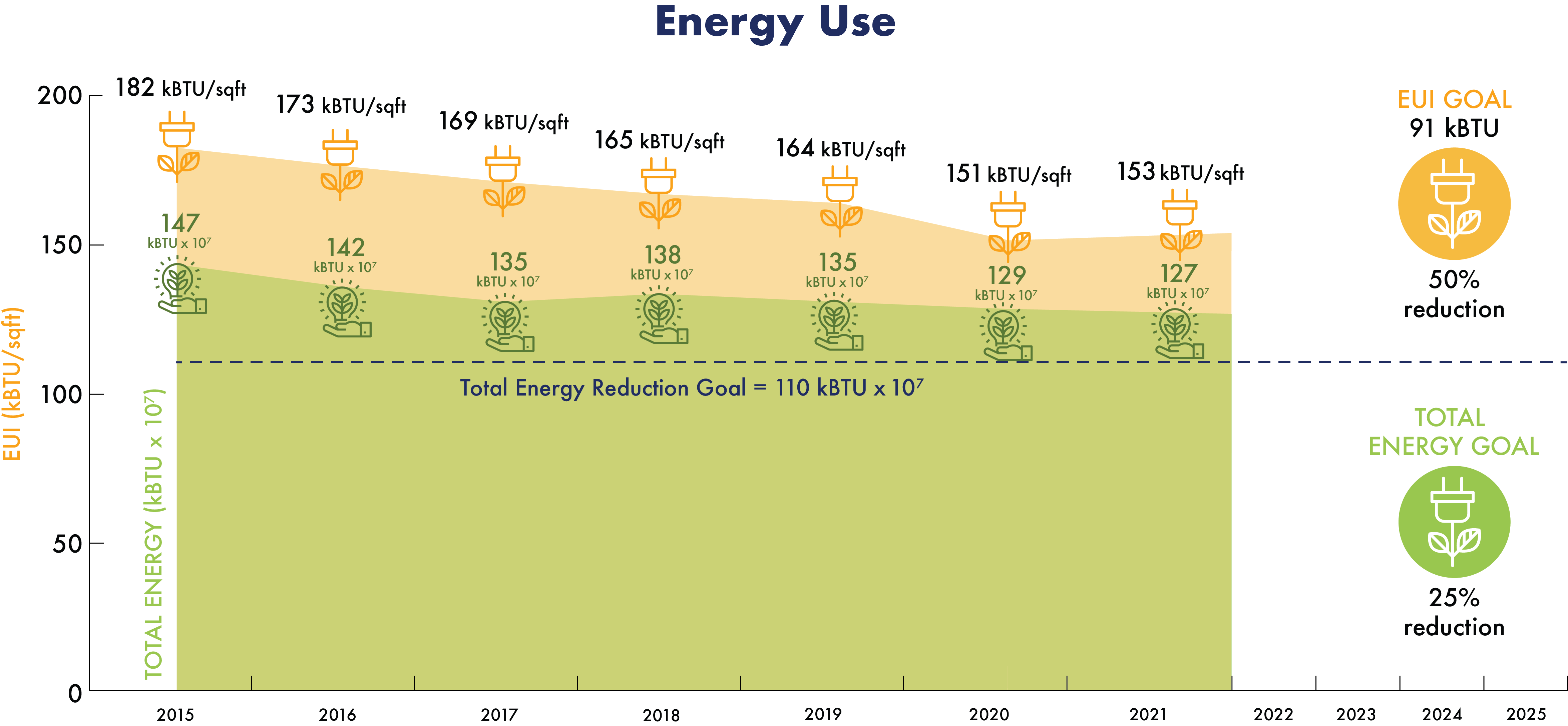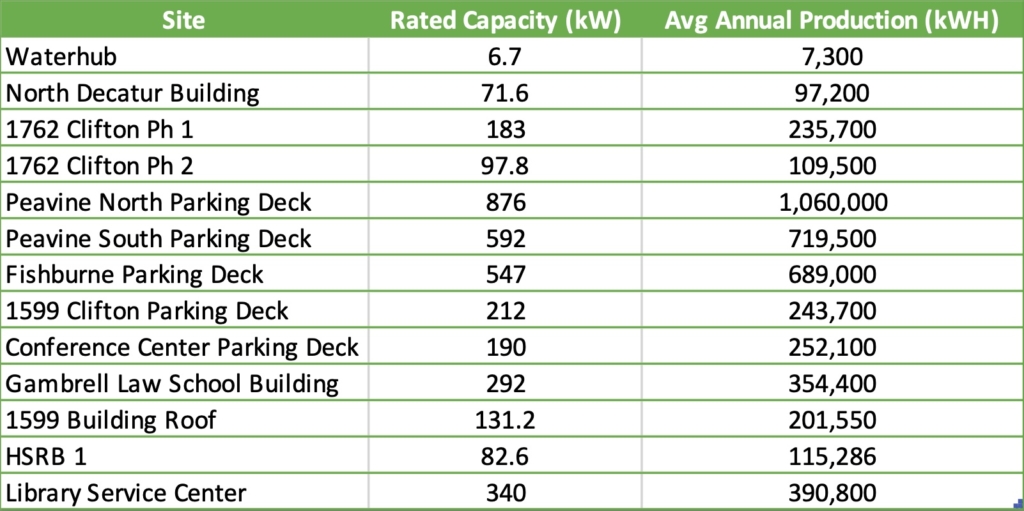Electricity production is the second largest source of greenhouse gas emissions in the United States, representing 25% of 2020 emissions (U.S. EPA). In 2021, natural gas and coal contributed to approximately 60% of Georgia’s total electricity net generation (EIA). Because of the public health and climate impacts of fossil fuel use, Emory’s 2025 Sustainability Vision focuses on energy efficiency and the increased use of renewable energy to mitigate climate change and improve air quality. Achieving this goal will require everyone – from administrators investing in energy-efficient systems to individuals changing their habits by turning off lights and computers-to commit to reducing our collective energy footprint.
So Far
- In 2020, Emory signed a transformative solar power agreement with Cherry Street Energy. In doing so, Emory pledged to install more than 15,000 solar panels across 16 buildings on its Druid Hills campus, which will generate approximately 10 percent of Emory’s peak energy requirements and reduce Emory’s greenhouse gas emissions by about 4,300 metric tons.
- Since 2015, Emory has achieved an overall energy use per square foot (EUI) reduction of 15.3% and an overall total energy reduction of 14.1%. Read more about Emory’s energy usage in the Energy Efficiency page and in the 2023 Annual Energy & Utilities Report.
- Renewable energy is on rise at Emory. In 2021, Emory’s solar projects produced over 2710 MWh of electricity, a 410% increase over 2020. The Emory Student Center harnesses energy from solar panels to preheat potable water and uses a system of geothermal wells to help heat and cool the facility.
- Emory is enrolled in the Department of Energy’s Smart Lab Accelerator program, which works to advance strategies that rapidly improve energy efficiency in laboratory buildings. In 2019 Emory was acknowledged for its outstanding participation in the program by surpassing the 5% reduction target with a 7.2% reduction in one lab building’s energy use over two years.
- Further information regarding Emory’s efforts to reduce carbon emissions from energy use can be found in the FY2021 Greenhouse Gas Emissions Inventory Report. The executive summary can be viewed here and the full report here.
 Click image for a larger view
Click image for a larger view
Emory’s 2025 Vision goal is to reduce energy use per square foot by 50% in University buildings and 25% in Healthcare buildings. This graph shows progress toward the University goal in buildings on the Druid Hills and Oxford campuses.
Today
- A 1mW combined heat and power system operates in Emory’s steam plant. This system recovers mechanical heat produced by Emory’s natural gas generators.
- Emory’s $1.5million Sustainability Revolving Fund supports energy efficiency projects.
- Emory University and Emory Healthcare participate in the Atlanta Better Buildings Challenge, a national competition to reduce energy and water consumption by 20 percent by 2020. Each year, Emory buildings are recognized as Top Performers.
- Emory’s Sustainable Performance Program (SPP) strives to keep building HVAC systems optimized and prevent performance degradation.
- A temperature control policy and weekend, evening, and holiday building shutdowns decrease energy consumed to heat and cool Emory’s buildings, which are Emory’s largest stationary source of energy use.
- Emory’s annual Energy Competition awards buildings that reduce the most energy throughout the month.
$853k
and 12.4 million KWh saved by converting parking deck lights to LEDs as of 2020.
$13k
saved in energy costs during the 2020 holiday building turndown.
3,136 MWh
of electricity produced from on-campus solar and steam energy in 2020.
Tomorrow
Emory is committed to reducing energy consumption and meeting building expansion, design, and construction standards. By 2025, Emory strives to:
- Reduce campus energy use per square foot by 50 percent and total energy use by 25 percent.
- Reduce Emory Healthcare energy use by 25 percent.
- Self-generate 10 percent of campus energy to replace fossil fuel sources.
- Incorporate major building renovations into LEED silver commitment or higher and attain best practices for sustainable performance in building interiors.
- Incorporate regenerative architectural standards such as net zero impact and “living building” in the new Campus Life Center and other innovative facilities.
- Reduce campus water consumption by 50 percent.
Completed Solar Projects:

Locations Under Design:
- Musculoskeletal Parking Deck Canopy
Locations to be designed that are included in SEPA:
- Starvine Parking Deck
- Lowergate East Parking Deck
- Lowergate South Parking Deck
Solar PV on Lowergate South Parking Deck
Future site of solar panel installation as part of the Solar Energy Procurement Agreement (SEPA) with Cherry Street Energy!
Solar PV on Health Sciences Research Building I Rooftop
In December 2020, solar panels were installed on the Health Sciences Research Building I in the initial phase of the Emory-Cherry Street Energy Solar Energy Procurement Agreement (SEPA) project.
Solar PV Gambrell School of Law Rooftop
In November 2020, 83kw of rooftop solar was installed on the Gambrell School of Law building rooftop and parking deck top floor in the initial phase of the Emory-Cherry Street Energy Solar Energy Procurement Agreement (SEPA) project.
Solar PV on 1599 Clifton Road Building Rooftop
In August 2020, 83kw of rooftop solar was installed on the 1599 Clifton Road building rooftop and parking deck top floor in the initial phase of the Emory-Cherry Street Energy Solar Energy Procurement Agreement (SEPA) project.
Solar PV on Peavine South Parking Deck
In Spring 2021, solar panels were installed on the Peavine South Parking Deck in the initial phase of the Emory-Cherry Street Energy Solar Energy Procurement Agreement (SEPA) project.
Solar PV on Peavine North Parking Deck
In Spring 2021, solar panels were installed on the Peavine North Parking Deck in the initial phase of the Emory-Cherry Street Energy Solar Energy Procurement Agreement (SEPA) project.
Solar PV on Fishburne Parking Deck
In June 2021, solar panels were installed on the Fishburne Parking Deck in the initial phase of the Emory-Cherry Street Energy Solar Energy Procurement Agreement (SEPA) project.
Solar PV on Emory Conference Center Hotel Parking Deck
In Fall 2020, solar panels were installed on the Emory Conference Center Hotel Parking Deck in the initial phase of the Emory-Cherry Street Energy Solar Energy Procurement Agreement (SEPA) project.
Solar PV on Clairmont Starvine Parking Deck
Future site of solar panel installation as part of the Solar Energy Procurement Agreement (SEPA) with Cherry Street Energy!
Solar PV on 1599 Clifton Road Parking Deck Canopy
In Fall 2020, solar panels were installed on the 1599 Clifton Road Parking Deck Canopy in the initial phase of the Emory-Cherry Street Energy Solar Energy Procurement Agreement (SEPA) project.
Co-generation or Combined Heat and Power
A steam-turbine generator at Emory’s steam plant produces one megawatt of clean power for the campus. Emory’s steam plant burns natural gas to create pressurized steam. Cogeneration/CHP recovers mechanical heat produced by turning generators, adds that heat to the steam system and is able to generate even more electricity by spinning the steam turbine under higher pressures. Link: https://sustainability.emory.edu/emory-university-adds-1mw-of-clean-power-with-innovative-cogeneration-combined-heat-and-power-system/
Geothermal Energy at McDonough Field
A system of 400-foot deep geothermal wells dug into McDonough Field provide some 700 tons of heating/cooling capacity to the Emory Student Center.
Solar PV on 1762 Clifton Rd Rooftop
Emory installed its first rooftop solar panels in the summer of 2015 through participation in Georgia Power’s Advanced Solar Initiative. The 1762 Clifton Road rooftop panels were installed at the same time as the North Decatur rooftop panels, which together generate 265 kWh of energy. Solar is one strategy for achieving Emory’s goals of 45% GHG emissions reductions by 2030, and carbon neutrality by 2050.
Solar Water Heating at Emory Student Center
A solar water heating system located in the rectangular panels on the roof of the North Pavilion provides about 40 percent of the building’s hot water needs.
Solar PV at the WaterHub
Solar PV on North Decatur Building Rooftop
Emory installed its first rooftop solar panels in the summer of 2015 through participation in Georgia Power’s Advanced Solar Initiative. The North Decatur Building rooftop panels were installed at the same time as the 1762 Clifton Road rooftop panels, which together generate 265 kWh of energy. Solar is one strategy for achieving Emory’s goals of 45% GHG emissions reductions by 2030, and carbon neutrality by 2050.
Solar PV on EmTech Library Service Center Rooftop
In June 2022, solar panels were installed on the Library Services Center in the initial phase of the Emory-Cherry Street Energy Solar Energy Procurement Agreement (SEPA) project.
The EmTech Library Service Center, created in collaboration between Emory University and the Georgia Institute of Technology, opened its doors in March 2016. The Library Service Center was built to house a shared collection amassing millions of books and other materials , with the goal of making these materials seamlessly available to faculty, staff, and students at both Emory and Georgia Tech. This joint project marks the latest chapter in a longstanding public-private partnership between the Atlanta-based institutions and offers advantages for both universities. The solar panels on this building help mitigate the building’s energy use while advancing both universities’ missions of increased sustainability and environmental awareness.
Solar PV on Lowergate East Parking Deck
Future site of solar panel installation as part of the Solar Energy Procurement Agreement (SEPA) with Cherry Street Energy!
